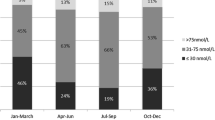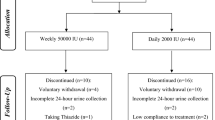Abstract
Introduction
In this paper, we investigated whether cholecalciferol supplementation may increase the risk of stone recurrence in patients with calcium nephrolithiasis and Vitamin D deficiency.
Methods
Thirty-three stone formers (56 ± 17 years old, 12 males) with 25(OH)D < 20 ng/mL were considered. Calcium excretion and urine supersaturation with calcium oxalate (ßCaOx) and brushite (ßbsh) were evaluated, both before and after cholecalciferol supplementation. Values of ß > 1 mean supersaturation. Cholecalciferol was prescribed as oral bolus of 100,000–200,000 IU, followed by weekly (5000–10,000 IU) or monthly (25,000–50,000 IU) doses. Calcium intake varied between 800 and 1000 mg/day.
In urine, total nitrogen (TNE) was taken as an index of protein intake, sodium as a marker of dietary intake, and net acid excretion (NAE) as an index of acid–base balance.
Results
TNE, sodium, and NAE did not change during the study (p = ns). Compared to baseline values, after cholecalciferol, both serum calcium and phosphate did not vary (p = ns); 25(OH)D increased from 11.8 ± 5.5 to 40.2 ± 12.2 ng/mL (p < 0.01); 1.25(OH)2D increased from 41.6 ± 17.6 to 54 ± 16 pg/mL (p < 0.01); PTH decreased from 75 ± 27.2 to 56.7 ± 21.1 pg/mL (p < 0.01); urinary calcium increased from 2.7 ± 1.5 to 3.6 ± 1.6 mg/Kg b.w. (p < 0.01); ßbsh increased from 0.9 ± 0.7 to 1.3 ± 1.3 (p = 0.02); whereas ßCaOx varied but not significantly. Before cholecalciferol supplementation, 6/33 patients were hypercalciuric (i.e., urine Ca ≥ 4 mg/Kg b.w.) and increased to 13/33 after cholecalciferol supplementation (pX2 = 0.03).
Conclusions
Cholecalciferol supplementation may increase calcium excretion, or reveal an underlying condition of absorptive hypercalciuria. This may increase both urine supersaturation with calcium salts and stone-forming risk.


Similar content being viewed by others

References
Holick MF (2017) The vitamin D deficiency pandemic: approaches for diagnosis, treatment and prevention. Rev Endocr Metab Disor 18:153–165
Manson JE, Brannon PM, Rosen CJ, Taylor CL (2016) Vitamin D deficiency—is there really a pandemic? N Engl J Med 375(19):1817–1820
Holick MF, Binkley NC, Bischoff-Ferrari HA et al (2011) Endocrine society. Evaluation, treatment, and prevention of vitamin D deficiency: an endocrine society clinical practice guideline. J Clin Endocrinol Metab 96(7):1911–1930
Ross AC, Manson JE, Abrams SA et al (2011) The 2011 report on dietary reference intakes for calcium and vitamin D from the Institute of Medicine: what clinicians need to know. J Clin Endocrinol Metab 96(1):53–58
Giron-Prieto MS, Cano-Garcia MC, Arrabal-Polo MA et al (2016) Analysis of vitamin D deficiency in calcium stone-forming patients. Int Urol Nephrol 48:1243–1246
Johri N, Jaeger P, Ferraro PM et al (2017) Vitamin D deficiency is prevalent among idiopathic stone formers, but does correction pose any risk? Urolithiasis 45(6):535–543
Ticinesi A, Nouvenne A, Ferraro PM et al (2016) Idiopathic calcium nephrolithiasis and hypovitaminosis D: a case-control study. Urology 87:40–45
Tang J, McFann KK, Chonchol MB (2012) Association between serum 25-hydroxyvitamin D and nephrolithiasis: the National Health and Nutrition Examination Survey III, 1988–1994. Nephrol Dial Transplant 27:4385–4389
Taylor EN, Hoofnagle AN, Curhan GC (2015) Calcium and phosphorus regulatory hormones and risk of incident symptomatic kidney stones. Clin J Am Soc Nephrol 10:667–675
Worcester EM, Coe FL (2008) New Insights into the pathogenesis of idiopathic hypercalciuria. Semin Nephrol 28(2):120–132
Fuss M, Pepersack T, Van Geel J et al (1990) Involvement of low-calcium diet in the reduced bone mineral content of idiopathic renal stone formers. Calcif Tissue Int 46(1):9–13
Letavernier E, Traxer O, Daudon M et al (2011) Determinants of osteopenia in male renal-stone–disease patients with idiopathic hypercalciuria. Clin J Am Soc Nephrol 6:1149–1154
Jaeger P, Lippuner K, Casez JP et al (1994) Low bone mass in idiopathic renal stone formers: magnitude and significance. J Bone Miner Res 9(10):1525–1532
Taylor EN, Feskanich D, Paik JM, Curhan GC (2016) Nephrolithiasis and risk of incident bone fracture. J Urol 195(5):1482–1486
Lauderdale DS, Thisted RA, Wen M, Favus MJ (2001) Bone mineral density and fracture among prevalent kidney stone cases in the Third National Health and Nutrition Examination Survey. J Bone Miner Res 16(10):1893–1898
Berlin T, BjorkhemI CL et al (1982) Relation between hypercalciuria and vitamin D3-status in patients with urolithiasis. Scand J Urol Nephrol 16:269–273
Eisner BH, Thavaseelan S, Sheth S et al (2012) Relationship between serum vitamin D and 24 h urine calcium in patients with nephrolithiasis. Urology 80:1007–1010
Nguyen S, Baggerly L, French C et al (2014) 25-Hydroxyvitamin D in the range of 20 to 100 ng/mL and incidence of kidney stones. Am J Public Health 104:1783–1787
Aloia JF, Dhaliwal R, Shieh A et al (2014) Vitamin D supplementation increases calcium absorption without a threshold effect. Am J Clin Nutr 99(3):624–631
Billington EO, Burt LA, Rose MS et al (2020) Safety of high-dose vitamin D supplementation: secondary analysis of a randomized controlled trial. J Clin Endocrinol Metab 105(4):1–13
Malihi Z, Wu Z, Stewart AW et al (2016) Hypercalcemia, hypercalciuria, and kidney stones in long-term studies of vitamin D supplementation: a systematic review and meta-analysis. Am J Clin Nutr 104:1039–1051
Leaf DE, Korets R, Taylor EN et al (2012) Effect of vitamin D repletion on urinary calcium excretion among kidney stone formers. Clin J Am Soc Nephrol 7(5):829–834
Ferroni MC, Rycyna KJ, Averch TD, Semins MJ (2017) Vitamin D repletion in kidney stone formers: a randomized controlled trial. J Urol 197:1079–1083
Ferraro PM, Taylor EN, Gambaro G, Curhan GC (2017) Vitamin D Intake and the risk of incident kidney stones. J Urol 197:405–410
Malihi Z, Lawes CMM, Wu Z et al (2019) Monthly high-dose vitamin D supplementation does not increase kidney stone risk or serum calcium: results from a randomized controlled trial. Am J Clin Nutr 109(6):1578–1587
Oh MS (1989) A new method for estimating G-I absorption of alkali. Kidney Int 36:915–917
Vitale C, Marangella M, Cosseddu D et al (1997) Clinical and biochemical patterns of presentation in monolateral and bilateral calcium nephrolithiasis. Clin Nephrol 47(1):23–27
Curhan GC, Willett WC, Speizer FE, Stampfer MJ (2001) Twenty-four hour urine chemistries and the risk of kidney stones among women and men. Kidney Int 59(6):2290–2298
Stechman MJ, Loh NY, Thakker RV (2009) Genetic causes of hypercalciuric nephrolithiasis. Pediatr Nephrol 24(12):2321–2332
Song L, Maalouf NM (2017) 24-hour urine calcium in the evaluation and management of nephrolithiasis. JAMA 318(5):474–475
Bingham SA (2003) Urine nitrogen as a biomarker for the validation of dietary protein intake. J Nutr 133(Suppl 3):921S–924S
Magee EA, Curno R, Edmond LM, Cummings JH (2004) Contribution of dietary protein and inorganic sulfur to urinary sulfate: toward a biomarker of inorganic sulfur intake. Am J Clin Nutr 80(1):137–142
McCarron DA, Kazaks AG, Geerling JC et al (2013) Normal range of human dietary sodium intake: a perspective based on 24-Hour urinary sodium excretion worldwide. Am J Hypertens 26(10):1218–1223
Marangella M, Daniele PG, Ronzani M et al (1985) Urine saturation with calcium salts in normal subjects and idiopathic calcium stone formers estimated by an improved computer model system. Urol Res 13:189–193
Ritter CS, Armbrecht HJ, Slatopolsky E, Brown AJ (2006) 25-Hydroxyvitamin D3 suppresses PTH synthesis and secretion by bovine parathyroid cells. Kidney Int 70:654–659
Al-Aly Z, Qazi RA, González EA et al (2007) Changes in serum 25-hydroxyvitamin D and plasma intact PTH levels following treatment with ergocalciferol in patients with CKD. Am J Kidney Dis 50(1):59–68
Christakos S, Dhawan P, Porta A et al (2011) Vitamin D and intestinal calcium absorption. Mol Cell Endocrinol 347(1–2):25–29
Jones G (2015) Interpreting vitamin D assay results: proceed with Caution. Clin J Am Soc Nephrol 10(2):331–334
Author information
Authors and Affiliations
Contributions
CV: project development, data analysis, manuscript writing; MM: data analysis, manuscript editing; FB: data management; LF: data collection; AT: data collection.
Corresponding author
Ethics declarations
Conflict of interest
The authors declare that they have no conflict of interest.
Research involving human participants and/or animals
All procedures performed in studies involving human participants were in accordance with the ethical standards of the institutional and/or national research committee and with the 1964 Helsinki declaration and its later amendments or comparable ethical standards.
Informed consent
Informed consent was obtained from all individual participants involved in the study.
Additional information
Publisher's Note
Springer Nature remains neutral with regard to jurisdictional claims in published maps and institutional affiliations.
Rights and permissions
About this article
Cite this article
Vitale, C., Marangella, M., Bermond, F. et al. Metabolic effects of cholecalciferol supplementation in patients with calcium nephrolithiasis and vitamin D deficiency. World J Urol 39, 597–603 (2021). https://doi.org/10.1007/s00345-020-03222-y
Received:
Accepted:
Published:
Issue Date:
DOI: https://doi.org/10.1007/s00345-020-03222-y



